Text and Photos by Jeffrey A. Rendall
GETTYSBURG, PA -- Some things happen by chance -- you could call it luck, or you might just as easily call it fate. Having two 19th century armies meet in this small town in the middle of Pennsylvania farm country just across the Mason-Dixon line from Maryland must be classified at tragic bad luck (or ill fate) for its inhabitants at the time. But it didn't just happen by chance.
The Battle of Gettysburg, legend has it, occurred because there was a shoe factory in town that the invading Confederate forces wanted to get a hold of. But the more likely cause of the battle was the town's location -- the convergence point for seven roads that came from all directions. The hamlet was a good place to consolidate a scattered army, a fact that wasn't lost on Confederate General Robert E. Lee and Union General George Meade. Fact is, Gettysburg was a perfect setting for a military pow-wow.
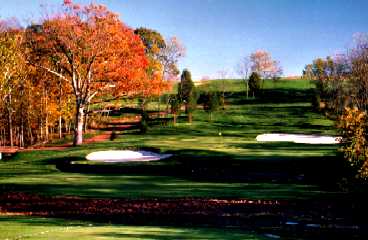 |
| You'll need to carry a stone wall to reach the first green. Photo Courtesy of The Links At Gettsyburg. |
Continuing the irony, the southern forces entered from the north, and the northern forces came from the south. All met at Gettysburg, and the rest is history -- three days of fighting that sapped the offensive power of the Confederate army for the balance of the war. Lee's army may not have surrendered until after the fall of Richmond in April of 1865, but the inevitable outcome was largely decided on those three days in July of 1863 at Gettysburg. Pretty heavy stuff, when you ponder it.
Similarly, even today, all local roads still seem to lead to the same small town in southern Pennsylvania -- for those seeking to tour the ground where Lincoln said the soldiers gave 'the last full measure of devotion.' And, just as Gettysburg seemed to be a good place to conduct a battle, it's also is proving to be a great place to play golf.
Who would have ever guessed that folks in the Baltimore and Washington areas would return to Gettysburg to take some more shots -- but this time, it's a little white ball acting as the projectile, and a flagstick on a green as the target. The Links at Gettysburg opened in July of 1999, and golfers from all over the three state area (Virginia, Maryland and Pennsylvania) converged to give it a try. There's been a canister shot of praise for this layout since the grand opening, and it's not just because of its proximity to Little Round Top.
And somewhat surprisingly, most of the course's clientele isn't related to the town's considerable tourist industry. Joe Burden, the Links' General Manager, says most people who come to play the course are there just for the golf. "We've found that the vast majority of golfers out here are visiting just for the golf. There's no denying that the battlefield is a tremendous tourist draw, but the people who visit the national park are generally there for a day or two vacation or a camping trip. We're focusing on attracting the region's serious golfers, and I think we've got a great course here to lure them."
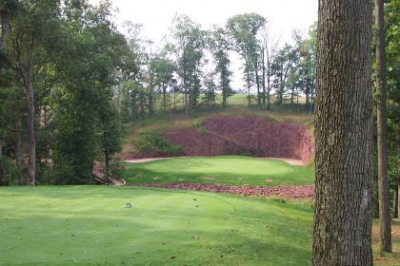 |
| The 187 yard 3rd hole plays downhill to a green backed by a steep red rock cliff. No doubt, a unique scene around these parts. |
After playing the layout, it's not a shocker at all to see why someone would make the drive out here to discover tee markers instead of monuments. It's a layout that plays much more difficult than its relatively mild 128 Slope (from the back tees) would indicate. In fact, I couldn't believe the rating when I saw it, thinking it would have to be in the high 130's.
Burden says the tame rating's because there aren't a lot of forced carries or a plethora of fairway bunkers. That may be true, but what you will find is a fairly tight layout bordered on many holes by woods or water. It's quite a visual test, and if you're not bringing your straight clubs, you're in trouble. Friendly slope rating or not, there's plenty to think about -- thank goodness in the 21st century it isn't in the form of exploding shells or bayonet charges.
Not surprising are the aesthetics of the area. Anyone who's ever visited this region of the country knows what an exquisite mix of variation the topography presents, and the Links at Gettysburg has more than its share of beauty in the form of red rock cliffs, open fields, wooded glades and mountain views. It almost begs you to throw a blanket and picnic basket in the back of the cart.
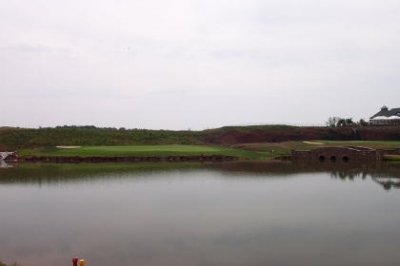 |
| The par three 12th hole mandates a considerable water carry to reach it -- but you can also get there by walking across the attractive stone bridge. |
No wonder the beautiful clubhouse holds so many weddings -- I can't think of a better spot for life's ultimate vows (and it overlooks the eighteenth green, too!).
As previously mentioned, the course plays as a tight test of shotmaking. I wouldn't call it target golf, but there really isn't enough room to call it wide-open. The course was laid out by course architect Lindsay Ervin, then finished by land developer Stephen Klein, the cousin of the owner (and golf enthusiast), Rick Klein. The course truly is a family operation, as the owner resides on the property -- and it shows in the care the place receives.
The layout, like the land, shows excellent variety. There are tree-lined parkland holes, open links-style holes, water holes (including an island green), target holes, uphill shots and downhill shots. And because the course doesn't play overly long, you'll be able to select your clubs off the tee. I'd say this is a layout where you can easily score well without hitting driver more than three or four times. A thinking man's (or woman's!) course.
The greens will challenge you, however. They're quite undulated and accurate iron placement's a must if you want to avoid three putts. I hit quite a few greens in regulation, but shot higher than my normal score because I couldn't lag putt to respectable distances. No doubt, playing the course a couple more times would help to score better.
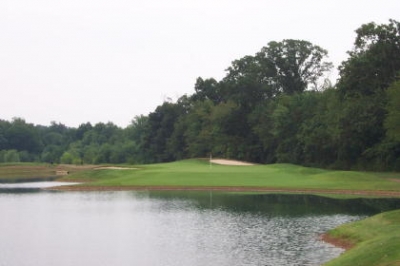 |
| More water is found on the 233 yard, par three 15th. Standing on the tee, the green looks tiny. |
Turning to the layout, the first three holes are quite a testy opener to the round. The first is a 394 yard dogleg left par four with a downhill tee shot that could provide trouble in the woods if long or left. The cart's built in yardage book offers a description of every hole, but doesn't recommend clubbing down on any given tee. I will, however, and this is one where you should take less than a driver.
The second is a 395 yard dogleg right par four, with a tee shot over a ravine and bunkers on each side of the fairway. You'll need a driver's distance here to be able to clearly see the green around the dogleg -- and the second shot's over another ravine to an elevated green.
Three is probably the signature hole on the course, a 187 yard par three that plays severely downhill to a green surrounded by incredible red rock cliffs. Quite spectacular -- and once you get to the putting surface, you'll notice the undulations. Stay below the hole!
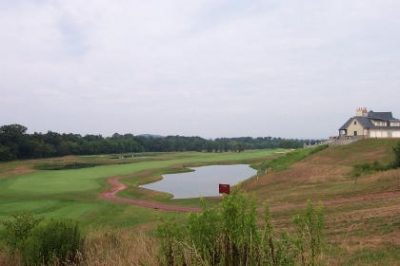 |
| Choose your teeing club carefully on the par five 7th. Neither short, long, left or right are great options on this interesting hole. |
The balance of the front nine plays out in more open territory, with four, five and six playing the easiest on the course. Seven is a great par five, with an elevated tee shot to a landing area bordered by lakes on both sides. Risk-reward all the way -- you'll need to decide how much of the lake on the right side you'll try to fly in order to cut off some distance. The smart play is an iron from the tee, but that'll leave two lengthy shots to the elevated green.
Eight is a nice short par four (323 yards) with a slight forced carry over a creek to a well -- bunkered fairway with red rock cliffs long. Another hole to club down off the tee.
Turning to the backside, number twelve is a scenic, island green par three with red rock cliffs in the background and water everywhere you look. Glance off to the right, and you'll see the waterfall that comes down from the clubhouse area. Very well done.
The closing sequence, thirteen through eighteen, may become as notorious for its challenge as Pickett's Charge was across the open fields to the northwest (okay, probably not, but the analogy sounds good). Thirteen's a 440 yard par four, water all down the left and woods to the right. The only bunker on the hole is in back of the green, but I doubt you're thinking about sand on this particular link.
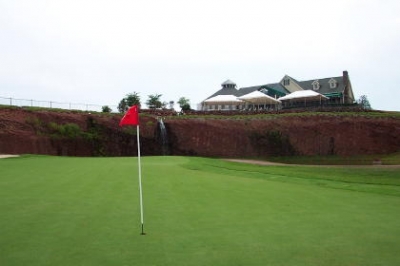 |
| A waterfall and red rock cliff separate the 18th green from the clubhouse. Luckily, the people above are not really in range. |
Fourteen's similar in challenge to the previous hole, though longer at 575 yards and a par five. Both holes have what looks like extremely narrow fairways.
Fifteen's a 233 yard par three, which someone cruelly marked as the #16 handicap hole. Water all down the left, there is a landing area in front and bunker long left to 'save' you from the water. If there was ever a time for a nice draw, this is it.
Sixteen's got water to the left and a creek in front of the green. If you're playing the back tees, it's also 490 yards of par four. There's generous room to miss on the right, but if you're in the rough, it'll be a layup and difficult try for a four.
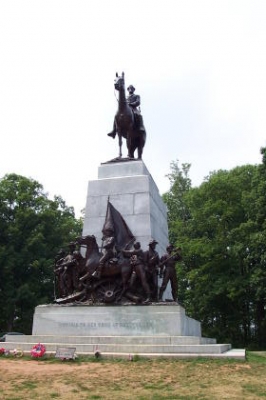 |
| Not far from the golf course, you'll discover the reason why this town is famous. |
Skipping to eighteen, this 539 yard par five may offer a chance to get a stroke back if you play it right. There's water on all three potential shots, but enough green area to allow for misses. The putting surface is surrounded by water on the long side, but if your third shot's a short one, is receptive to approach shots. This hole, like #12, plays right in front of the waterfall -- and potentially, a bridal party, as the clubhouse is right above you.
I was pleasantly surprised at the quality of the Links at Gettysburg -- my original expectations were that someone was using the famous battlefield's name to gain instant name recognition for a golf course. This is far from the truth -- and the fact that the roads still seem to lead here can only benefit those golfers in the surrounding region who'll want to come play it. Lucky for them, their trip to this excellent layout will not have been in vain. And as long as it's there -- golf of the people, by the people and for the people, shall not perish from the earth.
Details:
The Links At
601
Phone: (717) 359-8000
FAX: (717) 359-8020
Website: www.TheLinksAtGettysburg.com
Course Designers: Lindsay Ervin & Stephen Klein
Head Golf Professional: Tim Garrard
General Manager: Joe Burden (Note: Joe Burden is now the GM at Hollow Creek, the Links' sister course west of
|
|
Yardage/Slope |
Rating |
|
Gold |
7031/128 |
73.9 |
|
Blue |
6643/125 |
72.0 |
|
White |
6184/122 |
70.0 |
|
Green |
5710/116 |
67.8 |
|
Red |
4861/116 |
68.8 |
Rates (seven days A week):
Regular: $75 + tax; includes greens fee, cart fee and range balls. Twilight: $50; can vary depending on time of year. Call for off-season rates.
| Related Links | Comments on this article? | |
|
Maryland National Golf Club Hollow Creek Golf Club Rocky Gap Resort PB Dye Golf Club in Ijamsville Whiskey Creek Golf Club |
E-mail Jeff Rendall, Editor: jrendall@golftheunitedstates.com |











